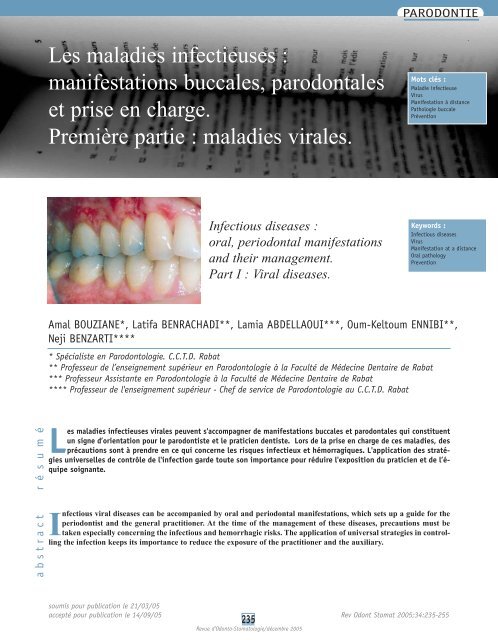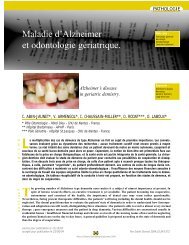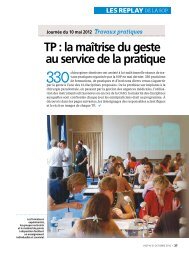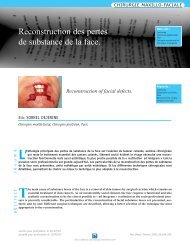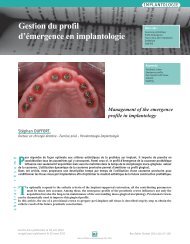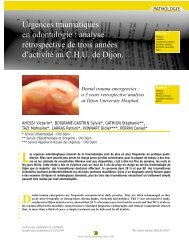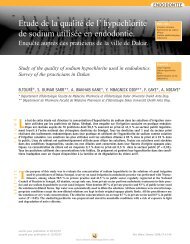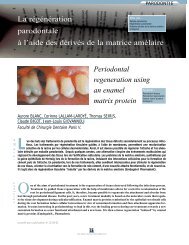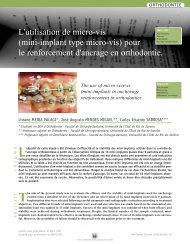⢠Bouziane:⢠Bouziane - SOP
⢠Bouziane:⢠Bouziane - SOP
⢠Bouziane:⢠Bouziane - SOP
- No tags were found...
Create successful ePaper yourself
Turn your PDF publications into a flip-book with our unique Google optimized e-Paper software.
PARODONTIELes maladies infectieuses :manifestations buccales, parodontaleset prise en charge.Première partie : maladies virales.Mots clés :Maladie infectieuseVirusManifestation à distancePathologie buccalePréventionInfectious diseases :oral, periodontal manifestationsand their management.Part I : Viral diseases.Keywords :Infectious diseasesVirusManifestation at a distanceOral pathologyPreventionAmal BOUZIANE*, Latifa BENRACHADI**, Lamia ABDELLAOUI***, Oum-Keltoum ENNIBI**,Neji BENZARTI***** Spécialiste en Parodontologie. C.C.T.D. Rabat** Professeur de l’enseignement supérieur en Parodontologie à la Faculté de Médecine Dentaire de Rabat*** Professeur Assistante en Parodontologie à la Faculté de Médecine Dentaire de Rabat**** Professeur de l'enseignement supérieur - Chef de service de Parodontologie au C.C.T.D. RabatrésuméLes maladies infectieuses virales peuvent s'accompagner de manifestations buccales et parodontales qui constituentun signe d’orientation pour le parodontiste et le praticien dentiste. Lors de la prise en charge de ces maladies, desprécautions sont à prendre en ce qui concerne les risques infectieux et hémorragiques. L'application des stratégiesuniverselles de contrôle de l'infection garde toute son importance pour réduire l'exposition du praticien et de l’équipesoignante.abstractInfectious viral diseases can be accompanied by oral and periodontal manifestations, which sets up a guide for theperiodontist and the general practitioner. At the time of the management of these diseases, precautions must betaken especially concerning the infectious and hemorrhagic risks. The application of universal strategies in controllingthe infection keeps its importance to reduce the exposure of the practitioner and the auxiliary.soumis pour publication le 21/03/05accepté pour publication le 14/09/05 Rev Odont Stomat 2005;34:235-255235Revue d’Odonto-Stomatologie/décembre 2005
PARODONTIEUne maladie infectieuse est une maladie due à desagents pathogènes classés en virus, bactéries etparasites. Ces micro-organismes exercent leurpouvoir pathogène à partir d’un réservoir et présententplusieurs modes de contamination. La survenue de l’infectiondépendrait de trois facteurs : la virulence bactérienne,la résistance de l’hôte et l’importance quantitativede la contamination.Ces maladies infectieuses présentent un certain nombrede manifestations buccales et parodontales qui peuventorienter le parodontiste ou le praticien dentistedans le diagnostic. Elles peuvent être classées en infectionsvirales, bactériennes et fongiques.La classification suivante est particulièrement sélectivedes maladies infectieuses qui peuvent avoir desmanifestations parodontales représentées pour la plupartpar des lésions gingivales. Des maladies infectieusescomme l’hépatite ne présentent pas de lésions gingivalesmais d’autres manifestations comme un ictèreou une gingivorragie.An infectious disease is due to pathogenic agentsclassified as viral, bacterial or parasitic. Thesemicroorganisms exercise their pathologic powerfrom a reservoir and present several modes of contamination.The onset of the infection depends on 3 factors:the bacterial virulence, the host resistance, and the quantitativeimportance of the contamination.These infectious diseases present a certain number oforal and periodontal manifestations, which can orientthe periodontist or the general practitioner in the diagnosis.It can be classified under viral, bacterial, andfungal infections.The following classification is particularly selective ofinfectious diseases that can have periodontal manifestationrepresenting most of these gingival lesions.Infectious diseases like hepatitis does not present gingivallesions but other manifestations like jaundice or gingivalbleeding.Infections virales :■ Hépatites virales■ Infection par le VIH■ Infections herpétiques (herpès, varicelle-zona etmononucléose infectieuse)■ Infection à virus Coxsackie du groupe AViral infections :■ Viral hepatitis■ Infection by HIV■ Herpetic infections (herpes, varicella-zona, infectiousmononucleosis)■ Coxsackie virus infection (Group A)Infections bactériennes :■ Tuberculose■ Infection à streptocoque■ Gonococcie■ Syphilis■ Infection par l’Helicobacter pyloriBacterial infections :■ Tuberculosis■ Infection to streptococcus■ Gonococci■ Syphilis■ Infection by Helicobacter pyloriInfections fongiques :■ HistoplasmoseActuellement, la classification de l’AAP de 1999(Armitage 1999) comporte la plupart des manifestationsparodontales de ces maladies infectieuses (entités: maladies gingivales d’origine bactérienne spécifique,d’origine virale, et d’origine fongique et la parodontiteulcéro-nécrotique).Dans la première partie de cet article, nous allons aborderles manifestations parodontales et la prise en chargebucco-dentaire des patients présentant des maladiesinfectieuses virales. La 2ème partie sera consacrée auxmaladies infectieuses bactériennes.Fungal infections :■ HistoplasmosisCurrently, the 1999 AAP classification (Armitage 1999)consists mostly of the periodontal manifestations ofthese infectious diseases (entity: gingival diseases withspecific bacterial, viral, fungal origin, and the ulceronecroticperiodontitis).In the first part of this article, we will deal with the periodontalmanifestations and the oral management ofpatients presenting these infectious viral diseases. Thesecond part will be consecrated to infectious bacterialdiseases.236Revue d’Odonto-Stomatologie/décembre 2005
Hépatites viralesLes hépatites sont des affections atteignant l’ensembledu parenchyme hépatique et s’accompagnantd’une réaction inflammatoire. Les principales étiologiessont :■ infectieuses virales (virus A, B, C, D, virus de lamononucléose infectieuse et cytomégalovirus) etbactériennes (leptospirose, listeria ou septicémies) ;■ médicamenteuses : cytolytiques, cholestatiques oumixtes ;■ toxiques (alcool par exemple) ;■ auto-immunes.Ce sont les plus fréquentes, caractérisées par uncontage, une phase pré-ictérique, et des transaminasestrès élevées (> 10 fois que la normale). Les virus deshépatites A, B, C et delta sont les plus fréquemment encause (Girard et coll., 1997).Viral hepatitisHepatitis is an ailment involving the ensemble ofthe liver parenchyma and is accompanied by an inflammatoryreaction. The principal etiologies are :■ viral infections (A, B, C, D virus, infectious mononucleosisvirus and cytomegalovirus) and bacterial (leptospirosis,listeria or septicemia) ;■ medicaments: cytolytics, cholestasis or mixes ;■ toxics : (alcohol for example) ;■ self-immunity.These are more frequently characterized by thetransmission/contamination, a pre-icterus phase, andvery high transaminases (> 10 times than normal). Thehepatitis A, B, C and delta viruses are more frequentlythe cause (Girard et al., 1997).Les virus responsablesVirus de l’hépatite ALe virus de l’hépatite A est composé de matérielgénétique (ARN) contenu dans une capside porteuse del’Ag HVA. Sa transmission se fait essentiellement parvoie digestive, par voie orale ou fécale. La période d’incubationest de 2 à 6 semaines. Cette forme ne progressepas vers la chronicité. Il s’agit d’une forme sanspersistance de l’état porteur. Elle est le plus souventobservée chez l’enfant et le jeune adulte.The virus responsibleHepatitis A virusThe hepatitis A virus is composed of geneticmaterial (RNA) contained in a capsid carrier of Ag HAV.The digestive, oral or fecal route essentially allows itstransmission. The incubation period is 2 to 6 weeks.This form does not progress towards chronicity. It involvesa non-persistant form of the state of the carrier. It ismore often observed in children and young adults.Virus de l’hépatite BLe virus de l’hépatite B est un virus à ADN d’unseul sérotype avec trois systèmes antigéniques (l’AgHBs pour la capsule externe, l’Ag HBc et HBe pour lanucléocapside interne, l’Ag HBe étant témoin de lacontagiosité). Le virus est retrouvé dans le sang et lessécrétions (sécrétions sexuelles, salive, sueur), mais pasdans les selles (car son enveloppe est détruite par lessécrétions digestives). L’incubation est de 2 à 6 mois.Elle touche surtout l’adulte. Le portage chronique estpossible (Girard et coll., 1997 ; Roche 1996 ; Aubert etGuittard, 1995).Sa transmission se fait principalement par voiesanguine et sexuelle, bien que d’autres voies de transmissionaient été suggérées, notamment la voie salivaire.Le virus peut utiliser cette voie pour une transmissionhorizontale (Pascal 1995). Il semblerait toutefoisHepatitis B virusThe virus involved in hepatitis B is a DNA virusof a single serotype with 3 antigenic systems (Ag HBsfor the external capsule, Ag HBc and Hbe for the internalnucleocapsid, Ag HBe being the control of the contagiousness).The virus is also found in the blood andsecretions (genital secretions, saliva, perspiration), butnot in the feces (because its envelope is destroyed by thedigestive secretions). Incubation is 2 to 6 months. Itaffects mostly adults. The chronic porterage is possible(Girard et al., 1997 ; Roche 1996 ; Aubert and Guittard,1995).Its transmission is done principally by blood orsexual route, although other pathways of transmissionhave been suggested, namely by the saliva. The viruscan use this route for a horizontal transmission (Pascal1995). It seems however that the saliva-saliva contact237Revue d’Odonto-Stomatologie/décembre 2005
PARODONTIEque le contact salive-salive ne soit pas en lui-même unevoie de contamination. La contamination par la salivenécessiterait une voie parentérale matérialisée par uneeffraction des muqueuses ou de l’épiderme, auquel casla transmission devient quasiment certaine. L’infectivitéde ce virus impose certaines précautions au cabinetdentaire pour protéger l’équipe soignante de l’infectiondirecte ou indirecte, et les patients de l’infection croisée(Ounsi et coll., 2003).does not in itself a route of contamination. The contaminationby the saliva necessitate a parenteral route carriedout by a break in the mucous or the epiderm, in this case,the transmission becomes practically certain. The infectivityof this virus imposes certain precautions in thedental clinic to protect the clinician and the auxiliaryfrom direct or indirect infection, and the patient fromcross infection (Ounsi et al., 2003).Virus de l’hépatite CLe virus de l’hépatite C est composé de matérielgénétique (ARN) contenu dans une capside, entouréeelle-même dans une enveloppe. Il est présent dans lesang. Dans les autres sécrétions sa présence n’est pasprouvée. Sa transmission est donc essentiellement sanguine.La transmission sexuelle est probable mais lerisque est faible (
123Fig. 1, 2 et 3 : Lichen plan buccal (cas aimablementprêté par le Dr L. Abdellaoui).Oral lichen planus (case Dr. L. Abdellaoui).■ Dans l’hépatite A, le taux d’Ig M est élevé dans laphase précoce puis il est suivi par une élévation desIg G dans les 2 à 3 mois.■ Dans l’hépatite B, le diagnostic repose sur la mise enévidence d’Ag de surface (Ag HBs).■ Dans la forme C, le diagnostic d’une hépatite chroniquerepose sur la mise en évidence des Ac anti-VHCpar un test ELISA. Ce test ne comporte pas de fauxnégatif chez les patients immunocompétents maisrisque de donner du faux positif notamment chez lespatients atteints de pathologie auto-immune.■ Dans l’hépatite D, le diagnostic repose sur la mise enévidence des Ac d.■ In hepatitis A, the level of IgM is elevated in the earlyphase then it is followed by an elevation in IgG in the2nd to the 3rd month.■ In hepatitis B, the diagnosis relay on revealing thesurface Ag (Ag HBs).■ In the C form, the diagnosis of a chronic hepatitisrelay on revealing the Ac anti-HCV by an ELISA test.This test does not consist of a false negative more particularlyin patients suffering from an autoimmunepathology.■ In hepatitis D, the diagnosis relay on revealing theAc d.Manifestations buccales et parodontales(Ounsi et coll., 2003 ; Greenwood et Meechan, 2003 ;Golla et coll., 2004).L’hépatite virale aiguë peut se manifester auniveau buccal par un ictère. La cavité buccale peut aussimontrer les signes hémorragiques de la dysfonctionhépatique (pétéchies, hématome, gingivorragies). Cesdernières associées à d’autres hémorragies (ecchymoses,hémorragies nasales, voire digestives) signeraientle passage à une hépatite fulminante. L’hépatite C chroniquea été associée au lichen plan buccal (Fig. 1, 2,3 et 4).Oral and periodontal manifestations(Ounsi et al., 2003 ; Greenwood and Meechan, 2003 ;Golla et al., 2004)Acute viral hepatitis can be orally manifested byjuandice. The oral cavity can also show hemorrhagicsigns of hepatic dysfunction (petechiae, hematoma, gingivalbleeding). The later is associated with otherhemorrhages (ecchymosis, nasal, and/or digestivehemorrhages) signaling the coming by of a threateninghepatitis. Chronic hepatitis C has been associated to orallichen planus (Fig. 1, 2, 3 and 4).239Revue d’Odonto-Stomatologie/décembre 2005
dans une cuve à ultrasons contenant du glutaraldéhydeà 2 % qui sera activée pendant 15 min. Les instrumentsresteront dans ce bain pour une période de 3 heuresavant le rinçage et le séchage. Le matériel sera ensuiteautoclavé selon la procédure habituelle.Les surfaces contaminables doivent être recouvertes,et celles contaminées être nettoyées en utilisantdes désinfectants de surface tels que l’hypochlorite desodium (laissé en place 30 min avant rinçage) ou leglutaraldéhyde (solution à 2 % laissée en place pendant3 heures). Il est donc recommandé, vu le temps nécessaireà la désinfection des surfaces, de prendre ce typede rendez-vous en fin de journée. Les films radiographiquesdoivent être placés dans des sachets protecteursavant la pose du film et le cône radiographiquerecouvert lui aussi d’une protection.Enfin, le praticien doit être à jour de sa vaccinationcontre l’hépatite B (Girard et coll., 1997 ; Ounsi etcoll., 2003).Lors de l’anesthésie, utiliser des doses faiblesdes solutions anesthésiques à fonction amine (lidocaïne,mépivacaïne, articaïne) chez les patients présentantune pathologie hépatique sévère. Une diminution del’activité métabolique augmente la toxicité des produitsanesthésiques injectés même si la quantité est relativementfaible (2 carpules). Le foie est le principal site del’activité métabolique, mais l’articaine (plasma) et laprilocaine (en partie dans les poumons) présententd’autres sites de métabolisme (Roche 1996 ; Greenwoodet Meechan, 2003 ; Golla et coll., 2004).Les troubles de l’hémostase peuvent être présentsen association avec des lésions hépatiques. Lestests demandés au patient doivent inclure une NFS(numération de la formule sanguine), le TP (taux deprothrombine), le TS (temps de saignement), ainsi queles tests de fonction hépatique (bilirubine, ALAT, ASAT).Ces tests destinés à détecter les troubles de l’hémostase,seront vérifiés avant tout type d’intervention chirurgicale.Si des taux élevés sont découverts et que desprocédures chirurgicales sont nécessaires, une attentionparticulière est destinée à minimiser le trauma. Si lerisque hémorragique est important, une transfusion duplasma frais congelé peut être indiquée en concertationavec l’hématologiste ou l’hépatologue. Les procédureschirurgicales complexes seront envisagées en milieuhospitalier (Girard et coll., 1997 ; Depaola 2003 ; Roche1996 ; Golla et coll., 2004).Lors de la prescription, l’utilisation de toutmédicament doit être discutée avec le médecin traitant.raldehyde that is activated for 15 minutes. Then theinstruments will remain in this solution for a period of 3hours before rinsing and drying. The materials will thenbe autoclaved according to the usual procedure.Surfaces that are prone to contamination must becovered and those that have been contaminated must becleaned by surface disinfectants such as sodium hypochlorite(left in place for 30 minutes before rinsing) orgluteraldehyde (2% solution left in place for 3 hours). Itis then recommended, considering the time necessaryfor the disinfection of surfaces, to practice this type ofprotocol at the end of the day. Radiographic films mustbe placed in protective sachets before film exposure andthe radiographic cone must also be covered with a protection.Finally, the practitioner must have an updatedvaccination against hepatitis B (Girard et al., 1997 ;Ounsi et al., 2003).At the time of the anesthesia, use minimum dosesof amine derived anesthetic solutions (lidocaine, mepivacaine,articaine) in patients presenting a severe hepaticpathology. A decrease in metabolic activity increasesthe toxicity of the anesthetic solutions injected even ifthe quantity is relatively low (2 carpules). The liver isthe principal site of metabolic activity, but articaine(plasma) and prilocaine (a part in the lungs) presentother sites of metabolism (Roche 1996 ; Greenwood andMeechan, 2003 ; Golla et al., 2004).Hemostasis disorders can be present in associationwith hepatic lesions. The tests asked from patientsmust include a CBC (Complete Blood Count), PT (prothrombintest), as well as tests on the hepatic function(bilirubin, ALT, AST). These tested are destined todetect the hemostatic disorders, which should be verifiedbefore any form of surgical intervention. If it is discoveredthat the level is elevated and that the surgicalprocedures are necessary, particular precaution must bedestined in minimizing the trauma. If the hemorrhagicrisk is important, a transfusion of fresh frozen plasmacan be indicated with the consent of a hematologist. Thecomplex surgical procedures must be performed in ahospital environment (Girard et al., 1997 ; Depaola 2003 ;Roche 1996 ; Golla et al., 2004).At the time of the prescription, the use of allmedicaments must be discussed with the treating physi-241Revue d’Odonto-Stomatologie/décembre 2005
PARODONTIEL’atteinte hépatique entraîne une diminution du métabolismemédicamenteux qui peut être à l’origine detoxicité. Dans certains cas, la réduction de la dose estrequise, alors que d’autres médicaments doivent êtrecomplètement évités (Greenwood et Meechan 2003 ;Golla et coll., 2004) :■ le miconazole (anti-fongique) est contre-indiqué. Lefluconazole nécessite une réduction ;■ pour les antibiotiques, l’érythromycine, le métronidazole,les tétracyclines, la streptomycine et l’acide clavulaniquedoivent être complètement évités ;■ les médications qui ont un effet anti-agrégant plaquettairenotamment les AINS augmentent le risqued’hémorragie gastro-intestinale et par conséquent,doivent être évitées. L’utilisation d’un antiacide oud’un inhibiteur des récepteurs H2 à l’histamine peutprévenir les gastrites et l’hémorragie gastro-intestinaleassociées à la dysfonction hépatique ;■ les doses du paracétamol doivent être réduites car lesfortes doses sont hépatotoxiques.cian. The hepatic illness causes a decrease in the metabolismof the medicaments that can be the origin of thetoxicity. In certain cases, decreasing the dose is required,while other medicaments must be completely avoided(Greenwood and Meechan 2003; Golla et al., 2004) :■ The miconazole (antifungal) is contraindicated. Thefluconazole needs to be reduced ;■ For the antibiotics: erythromycin, metronidazole,tetracycline, streptomycin, and acid clavulanic mustbe completely avoided ;■ Medications that have an antiplatelet effect more particularlythe NSAID increase the risk of gastrointestinalhemorrhage and as a result must be avoided. Theuse of an antacid or an inhibitor of H2 of histaminecan prevent gastritis and gastrointestinal hemorrhageassociated with an hepatic dysfunction ;■ The dose of paracetamol must be reduced becausestrong doses are hepatotoxic.Infection par le VIHet le SIDALe VIH (virus d’immunodéficience humaine) dugroupe des rétrovirus est à l’origine d’une maladie létalecaractérisée par une déficience immune progressiveet dont le stade ultime est le SIDA (syndrome d’immunodéficienceacquise). Le SIDA peut être défini commeun ensemble d’affections opportunistes, telle que lapneumocystose, et/ou de tumeurs, telles que le sarcomede Kaposi ou des lymphomes. L’infection virale esttransmise par des fluides contaminés (sang, sperme, etsécrétions vaginales).La prévention de la contamination a donc uneimportance primordiale.Infection by HIVand AIDSThe HIV (human immunodeficiency virus) of theretrovirus group is the origin of a lethal disease characterizedby a progressive immune deficiency and that thefinal stage is AIDS (acquired immune deficiency syndrome).The AIDS can be defined as a group of opportunisticinfections, such as the pneumocystosis, and/ortumors, like Kaposi sarcoma or lyphomas.Contaminated fluids (blood, sperm, and vaginal secretions)transmit the viral infection.The prevention from contamination is thus of primordialimportance.DiagnosticLe diagnostic immunologique repose sur larecherche d’anticorps VIH sériques par la méthodeELISA et par des tests de confirmation comme leWestern-blot. Le diagnostic hématologique repose surune lymphopénie majeure (la progression de l’infectionHIV vers le SIDA est définie par un taux des lymphocytesT CD4 inférieur à 200/mm 3 ), une anémie et unethrombopénie fréquentes favorisant l’apparition depétéchies voire de gingivorragies (Aubert et Guittard,1995 ; Girard et coll., 1997 ; Marx et Stern, 2003).DiagnosisThe immunologic diagnosis rests on the researchof an HIV antibody serum by the ELISA method and byconfirmation tests like the Western-blot. The hematologicdiagnosis rests on a major lymphopenia (the progressionof the HIV infection towards AIDS is definedby a level of lymphocytes T CD4 inferior to 200/mm3),an anemia and a thrombopenia frequently favors theapparition of petechiae and/or gingival bleeding (Aubertand Guittard, 1995 ; Girard et al., 1997 ; Marx and Stern,2003).242Revue d’Odonto-Stomatologie/décembre 2005
5 6Fig. 5 : Gingivite ulcéro-nécrotique.Ulcero-necrotic gingivitis.Fig. 6 : Parodontite ulcéro-nécrotique (cas aimablement prêté par PrO. Ennibi).Ulcero-necrotic periodontitis (case Pr O. Ennibi).Manifestations buccales et parodontalesLe chirurgien dentiste occupe une place primordialepour le diagnostic puisque les lésions buccalesassociées à l’infection VIH (candidose orale et leucoplasiechevelue) peuvent être la première expression decette infection (Girard et coll., 1997 ; Roche 1996 ;Maybaum). Des formes atypiques de maladies parodontalespeuvent aussi s’observer comme la gingivite ulcéro-nécrotique(Fig. 5), la parodontite ulcéro-nécrotique(Fig. 6) et l’érythème gingival linéaire. Ce dernierest une maladie gingivale d’origine fongique quipeut présenter un érythème intense de la gencive marginale,en forme de ruban, ou un érythème diffus quipeut s’étendre jusqu’au niveau de la ligne muco-gingivale(Ryder 2002 ; Holmstrup 1999 ; Zamanian et coll.,1997). L’histoplasmose, infection fongique opportunisteobservée au cours du SIDA, peut s’accompagner dansson entité africaine par des lésions de type nodulairesiégeant au niveau de la langue. Ces lésions peuvents’étendre au palais, aux lèvres, au pharynx et aux gencives(Girard et coll., 1997 ; Laskaris 1994 ; Armitage1999 ; Armitage 2004 ; Scully et coll., 1998).Les patients infectés par le VIH peuvent aussiprésenter des formes classiques de la maladie parodontaletelles que la parodontite chronique. Les étudesépidémiologiques ont montré chez les patients infectéspar le VIH, comparés à des populations contrôle, uneperte d'os et une perte d’attache plus importantes, etun plus grand nombre de récessions gingivales particulièrementlorsque le taux des lymphocytes CD4 est faible.Les profondeurs de sondage sont cependant moinsimportantes. Cette augmentation de la perte d’attacheet de la récession parodontale peut être due à desinfections atypiques fongiques, virales, et bactériennesOral and periodontal manifestationsThe dentist occupies a primordial position in thediagnosis since the oral lesions associated to an HIVinfection (oral candidosis and hairy leukoplakia) can bethe primary expression of this infection (Girard et al.,1997; Roche 1996; Maybaum). Atypical forms of periodontaldiseases can also be observed like the ulceronecroticgingivitis (Fig. 5), the ulcero-necrotic periodontitis(Fig. 6), and linear gingival erythema. Thelater is a gingival disease of fungal origin which can presentun intense erythema of the gingival margin, in formof a ribbon, or a diffused erythema which can extenduntil the level of the mucogingival line (Ryder 2002;Holmstrup 1999; Zamanian et al., 1997). Histoplasmosisis an opportunistic fungal infection observed at the courseof the AIDS, which can be accompanied by itsAfrican entity presenting nodular type lesions found onthe tongue. These lesions can develope on the palate, lips,and pharynx and on the gingiva (Girard et al., 1997 ;Laskaris 1994 ; Armitage 1999 ; Armitage 2004 ; Scullyet al., 1998).The patients infected by HIV can also presentclassical forms of periodontal disease such as chronicperiodontitis. Epidemiologic studies have shown inpatients infected by HIV, compared to control populations,a considerable loss in alveolar bone and attachment,and a high number of gingival recessions particularlywhen the level of lymphocytes CD4 is weak. Thepocket depths are however less significant. This increasein the loss of attachment and periodontal recessioncan be due to atypical fungal, viral, bacterial infectionsof the periodontium and/or an increase in the destructiveeffect on the host response (Barr et al., 1992 ; Lucht243Revue d’Odonto-Stomatologie/décembre 2005
PARODONTIE7Fig. 7 : La progression de l’infectionHIV non traitée vers le stadeSIDA et vers la mortd’après MARX R.E., et STERN D.The progression of non-treatedHIV infection towards the AIDSstage then to death (MARX R.E.,and STERN D.du parodonte et/ou une augmentation de l’effet destructeurde la réponse de l’hôte (Barr et coll., 1992 ;Lucht et coll., 1991 ; Neely et coll., 2001 ; Yeung etcoll., 1993 ; Ryder 2002). La détection d’une déplétionprogressive des lymphocytes CD4 peut indiquer si lepatient présente un risque d’infections opportunistes(Mariotti 2004 ; Marx et Stern 2003).et al., 1991; Neely et al., 2001; Yeung et al., 1993; Ryder2002). The detection of a progressive depletion of CD4lymphocytes can indicate if the patient presents a risk ofopportunistic infections (Mariotti 2004; Marx and Stern2003).Précautions à prendrelors de soins bucco-dentairesL’avis du médecin traitant est indispensableavant tout soin ou acte chirurgical :■ sur la pathologie du patient et son traitement.L’évaluation du stade et du degré de contrôle de l’infectionHIV est basée sur deux valeurs biologiquesspécifiques : la charge virale (copies/ml) et le tauxCD4. Pour mieux comprendre l’intérêt de ces deuxvaleurs, Stern et Marx (2003) proposent d’imaginer lepatient infecté par le HIV courant vers une falaise(Fig. 7). La vitesse avec laquelle l’individu court estreprésentée par la charge virale. Lorsqu’il atteint untaux de cellules CD4 de 200 cel/mm 3 , ceci indique lestade SIDA. Peu de temps après (autour de 50/mm 3 ),le patient atteint la falaise ;■ sur l’état du bilan biologique qui doit en plus dunombre CD4, renseigner sur le nombre des plaquettes.Precautions to be takenduring treatmentOpinion of the treating physician is indispensiblebefore any treatment or surgical act :■ regarding the pathology of the patient and his treatment,the evaluation of the stage and the degree ofcontrol of the HIV infection is based on 2 specificbiological values: the viral load (copies/ml) and thelevel of CD4. To better understand the interest ofthese 2 values, Stern and Marx (2003) propose to imaginean HIV infected patient running towards a cliff(Fig. 7). The viral load represents the speed withwhich the individual runs. When it reaches a CD4 cellularlevel of 200 cel/mm3, this indicates the AIDSstage. Shortly after (around 50/mm3), the patient reachesthe cliff ;■ regarding the biologic report, which must in additionto the number of CD4, give information on the numberof platelets.244Revue d’Odonto-Stomatologie/décembre 2005
Le risque infectieux prédomine chez les patientsimmunodéprimés (les patients ARC et SIDA). L’ARC(AIDS Related Complex) est une forme chroniquemineure manifestant des symptômes de l’infection VIHmais ne présentant pas pour autant de véritables critèresdu SIDA. Chez ces patients, une attention particulièresera portée à l’hygiène bucco-dentaire, une antibioprophylaxiedoit être proposée avant chaque acteavec une surveillance post-opératoire rigoureuse (Girardet coll., 1997 ; Roche 1996). Certains cliniciens utilisentle protocole d’une monoprise antibiotique uneheure avant l’acte dentaire, comme cela est de rigueurdans le cadre de la prévention de l’endocardite infectieuse.D’autres pensent que la prise d’antibiotiquesdoit se continuer aussi longtemps que des plaies ouvertessont présentes dans la cavité buccale (Depaola2003). Nous pensons que ce dernier protocole est lemoyen d’assurer une prophylaxie de couverture adéquatechez ces patients.Le risque hémorragique peut aussi être présentchez les patients infectés par le VIH. Il est lié d’unepart à la thrombocytopénie (taux de plaquettes inférieuresà 50.000 cellules/mm3) et nécessite l’explorationde l’hémostase primaire par un TS, et d’autre partà d’éventuelles troubles hépatiques explorés par le TP.L’allongement des tests nécessite l’avis du praticientraitant après réévaluation et obtention des informationsconcernant la nature des actes envisagés.Lors des prescriptions, l’acide acétyl salicylique,ses dérivés, et tout autre anti-inflammatoire non stéroïdiendoivent être évités si une thrombocytopénie estassociée. D’autres médicaments ne doivent pas être utilisésà cause de leurs interactions avec les inhibiteursdes protéases du traitement antiviral. Ces médicamentscomportent le propoxyphène pour les antalgiques, lemidazolam et le triazolam pour les agents psychotropes(alternatives : lorazepam, temazepam).Les précautions destinées à minimiser le risquede transmission sont les mêmes que pour les patientsporteurs du virus de l’HB (Girard et coll., 1997 ; Roche1996 ; Depaola 2003).The infectious risk is predominant in immunodepressivepatients (ARC and AIDS patients). The ARC(AIDS Related Complex) is a minor chronic form manifestingthe symptomes of HIV infection but does notpresent the true criteria of AIDS. In these patients, particularattention must be given to oral hygiene, an antibioticprophylaxis must be proposed before each actwith a rigorous post-operatory survaillance (Girard etal., 1997 ; Roche 1996). Certain clinicians use the protocolof taking a single dose of antibiotics an hour beforethe dental act, similar to that done in the prevention ofinfectious endocarditis. Others think that taking antibioticsmust be continued as long as the open wounds arepresent in the oral cavity (Depaola 2003). We think thatthis later protocol is the means to assure adequate prophylaticcoverage for these patients.A hemorrhagic risk can also be present in HIVinfected patients. It is linked partly by thrombopenia(platelet level inferior to 50.000 cells/ mm3) and requiresthe exploration of primary hemostasis by TS, and onthe other part by the eventual hepatic disorders exploredby TP. The extension of necessary tests needs the adviceof the treating physician after reevaluation and obtainingthe informations concerning the nature of the acts considered.During prescriptions, the acetyl salicylic acid, itsderivatives, and all other non-steroidal anti-inflammatorydrugs must be avoided if associated with thrombocytopenia.Other medicaments must not be used due totheir interactions with protease inhibitors of the antiviraltreatment. These medicaments include the propoxyphenefor analgesic, the midazolam and the triazolam forpsychotropic agents (alternatives: lorazepam, temazepam).The precautions destined to minimize the risk oftransmission are the same as for patients carrying theHB virus (Girard et al., 1997 ; Roche 1996 ; Depaola2003).Prise en charge parodontaleAvec le développement de nouveaux traitementscontre l’infection par le virus HIV tel que la thérapieanti-rétrovirale hautement active (HAART) à base detrithérapie, la progression au stade SIDA est retardée.Cela implique une tendance descendante dans l’apparitiondes formes atypiques des maladies parodontalesPeriodontal managementWith the development of new treatments againstthe HIV virus infection such as the highly active antiretrovirustherapy (HAART), which is the basis of thetri-therapy, the progression to the AIDS stage is delayed.This implicates a decreasing tendency in the apparitionof atypical form of periodontal diseases in HIV-infected245Revue d’Odonto-Stomatologie/décembre 2005
PARODONTIEchez le malade infecté par le HIV. En outre, les étudesrécentes, présentant un intérêt particulier pour le praticiendentiste, indiquent que les inhibiteurs des protéasesdu HAART peuvent inhiber directement les protéinasesaspartiques des candida. Cependant, le praticiendentiste devra encore faire face à des maladiesparodontales plus communes telles que la parodontitechronique, la gingivite liée à la plaque seule, la gingiviteliée à la plaque modifiée par d’autres facteurs, etc(Ryder 2002).Plusieurs études ont montré que les patientsséropositifs peuvent tolérer des traitements dentaires,tels que le détartrage-surfaçage radiculaire et lesextractions dentaires (Glick et coll., 1994 ; Lucartortoet coll., 1992 ; Robinson et coll., 1992 ; Ben Slama2004). Cependant, l’indication d’un certain nombre detraitements (en particulier les techniques chirurgicalesparodontales) devient plus restreinte en cas d’immunosuppressionsévère lors des stades les plus avancés del'infection HIV. Par exemple, si le taux des CD4 est audessousde 200, cela peut vraiment affecter la réponsecicatricielle au traitement parodontal. Ces options thérapeutiqueslimitées peuvent affecter le pronostic dentaireà long terme d’une façon défavorable. En revanche,la présence de profondeurs de sondage relativement faiblesassociés à des récessions parodontales, rend ceszones plus faciles à maintenir par un contrôle de plaqueadapté et à domicile (Ronderos et Ryder 2004).Dans le cas particulier de la réalisation de la chirurgieparodontale, certains sujets infectés par le HIVprésenteront, en plus du déficit immunitaire, un certaindegré de thrombocytopénie au cours de leur infectionHIV. Cette diminution du taux des plaquettes peut avoirun effet défavorable sur l’hémostase et le temps decoagulation pendant et après les interventions chirurgicalesparodontales. Par conséquent, le praticien devraitavoir les informations nécessaires sur le statut immunitaireet hématologique le plus récent du malade HIVavant de décider des actes chirurgicaux non urgents(Ronderos et Ryder, 2004 ; Ryder 2002).Dans les formes de maladie parodontale nécrotique,le traitement consiste en un détartrage grossierpour enlever la plaque bactérienne visible, les débrismous et les tissus nécrosés lorsqu’ils sont présents.L’irrigation par la polyvidone iodée (Bétadine®) est souventrecommandée lors de la procédure de débridementgrâce à ses effets anesthésiques et antiseptiques. Aprèsce débridement initial, des visites régulières fréquentessont recommandées pour enlever entièrement la plaque,le tartre, et les autres dépôts résiduels, et donner lesinstructions au malade sur le contrôle de plaque. Unpatients. In addition recent studies present a particularinterest for the practitioner indicating that the inhibitorsof HAART proteases can inhibit directly the asparticproteinases of candida. However, the practitioner muststill do by facing more common periodontal diseasessuch as chronic periodontitis, plaque-related gingivitis,and plaque-related gingivitis modified by other factors,etc. (Ryder 2002).Several studies have shown that the seropositivepatients can tolerate dental treatments, such as scalingrootplaning and dental extractions (Glick et al., 1994 ;Lucartorto et al., 1992 ; Robinson et al., 1992 ; BenSlama 2004). However, the indication of certain numberof treatments (in particular, periodontal surgical techniques)becomes more limited in the case of severeimmunosuppression during the more advance stages ofthe HIV infection. For example, if the level of CD4 isbelow 200, this can really affect the healing response toperiodontal treatment. These limited therapeutic optionscan affect the long-term dental prognosis, which becomeunfavorable. On the contrary, the presence of a relativelyminimal probing depth associated with periodontalrecessions, makes these zones easier to maintain byadapted and home plaque control (Ronderos et Ryder2004).In the case of carrying out a particular periodontalsurgery, certain HIV infected subjects present, inaddition of an immune deficit, a certain degree of thrombocytopeniain the course of their HIV infection. Thisdecrease in the level of platelets can have an unfavorableeffect on hemostasis and the time of coagulationduring and after peridontal surgical interventions.Consequently, the practitioner must have the informationsnecessary regarding the most recent immunologicaland hematological status of the HIV patient beforedeciding the non-urgent surgical acts (Ronderos andRyder, 2004 ; Ryder 2002).In the necrotic forms of periodontal disease, thetreatment consists of a superficial scaling to remove thevisible bacterial plaque, soft debris and necrotized tissueswhen present. Irrigation by povidone iodine(Bétadine®) is often recommended during the debridementprocedure thanks to its anesthetic and antisepticeffects. After this initial debridement, frequent regularvisits are recommended to remove entirely the plaque,calculus, and other residual deposits, and give plaquecontrolinstructions to the patient. A debridement followedby local irrigation of 0.2 % chlorhexidine and sys-246Revue d’Odonto-Stomatologie/décembre 2005
débridement suivi par une irrigation locale de chlorhexidineà 0.2 % et une prise systémique de 3-5 joursde métronidazole (Ryder 2002 ; Preshaw 2004 ;Zamanian et coll., 1997) peuvent être recommandés.Cette approche thérapeutique devrait être appliquéedès que possible puisque l'os et les tissus mous nécroséspeuvent s’étendre au niveau du palais et des tissusadjacents, entraînant un risque potentiellement morteld’un NOMA. Quelques centres cliniques qui traitent unnombre relativement important de malades HIV, recommandentl'usage des antibiotiques sélectifs tels que lemétronidazole comme adjuvant appréciable au traitement.Les antibiotiques doivent être utilisés avec prudenceet sur une courte durée du fait du risque de candidose.Toutefois, le spectre étroit des antibiotiquestels que le métronidazole peut préserver la plus grandeproportion de la flore Gram Positif prévenant la croissanceexcessive des candida (Ryder 2002 ; Robinson1997 ; Zamanian et coll., 1997).Dans le cas de l'érythème gingival linéaire, maladiegingivale d'origine fongique, l’absence de réponseau traitement conventionnel peut être due en partie àune invasion du tissu gingival par les candida. Pour prévenirla croissance excessive des candida, l'approchethérapeutique la plus courante est d’utiliser, en plus del’éviction des facteurs étiologiques, un agent fongicided’usage local, tels que les comprimés de nystatine(Mycostatine®), et dans les cas d'immunosuppressionplus sévère, le fluconazole à action systémique(Suprimase®, Triflucan®) (Ryder 2002 ; Laskaris 1996).Les infections à herpès simplex sont des infectionscommunes de maladies vénériennes. Après guérisonde la primo-infection, le virus s’installe de façonlatente dans les ganglions sensitifs des racines postérieuresde la moelle épinière avec possibilité de réactivationsendogènes. De nombreux facteurs peuvent favotemicintake of metronidazole for 3 to 5 days (Ryder2002 ; Preshaw 2004 ; Zamanian et al., 1997) can berecommended. This therapeutic approach must beapplied as soon as possible since the necrotized boneand soft tissues can reach the palate and the adjacent tissuesleading to a potential mortal risk of NOMA. Someclinical centers that treat a relatively large number ofHIV patients, recommend the use of selective antibioticssuch as metronidazole as an appreciable adjuvant to thetreatment. The antibiotics must be used with caution andat a short period to prevent the risk of candidosis.However, narrow spectrum antibiotics such as metronidazolecan preserve the largest proportion of GramPositive flora preventing the excessive growth of thecandida.In the case of linear gingival erythema, a gingivaldisease of fungal origin, the abscence of a response toconventional treatment can be due partly to an invasionof the gingival tissue by the candida. To prevent theexcessive growth of candida, the therapeutic approachthat is more commonly used, in addition to the evictionof the etiologic factors, is a local fungicidal agent suchas nystatin tablets (Mycostatin®). In more severe immunosuppressivecases, the use fluconazole of systemicaction (Suprimase®, Triflucan®) is recommended(Ryder 2002 ; Laskaris 1996).Infections herpétiquesLes herpès virus sont des opportunistes responsablesde maladies de la cavité buccale. Elles regroupentl’Herpes simplex hominis (HSV), le virus de la varicelleet du zona (VZV), le virus d’Epstein-Barr (EBV), lecytoméglovirus (CMV). Ce dernier est rarement responsabled’ulcérations buccales qui sont observées surtoutchez les malades immunodéprimés (Agbo-Godeau 2002 ;Szpirglas 2002).Infections à Herpès SimplexHerpetic infectionsThe herpes viruses are opportunistic and responsiblefor oral diseases. It comprises of the Herpes simplexhominis (HSV), the varicelle and zona (VZV), theEpstein-Barr virus (EBV), and the cytomegalovirus(CMV). The later is rarely responsible for oral ulcerations,which are observed more often in immunodepressedpatients (Agbo-Godeau 2002 ; Szpirglas 2002).Herpes simplex infectionsHerpes simplex infections are common venerealinfections. After recovering from a primary infection,the virus settles in a latent manner in the sensitive ganglionsof the posterior root of the spinal cord with thepossibility of endogene reactivations. The numerousfactors can favor recurrences: fever, menstruation, sun247Revue d’Odonto-Stomatologie/décembre 2005
PARODONTIE8Fig. 8 : Herpès labial.Labial herpes.riser les récurrences : fièvre, menstruations, soleil,infections, fatigue, stress. 4 à 48h avant l’éruption surviennentlocalement des paresthésies, des brûlures etun prurit (Girard et coll., 1997).Le diagnostic différentiel se pose avec une herpangine,une mononucléose infectieuse, une anginebactérienne, une aphtose buccale, un érythème polymorphe(Szpirglas et Benslama, 1999).infections, fatigue, stress. Within 4 to 48 hours beforethe eruption, local paresthesia, burns and a pruritusdevelops (Girard et al., 1997). The differential diagnosisbetween a herpangina, an infectious mononucleosis, abacterial sore throat, an oral aphthous, and a polymorphicerythema.Manifestations buccales et parodontalesL’herpès labial est l’infection herpétique la pluscommune due au virus Herpès simplex type I (Fig. 8).La primo-infection par le virus de l’herpès simplex peutentraîner une gingivite généralisée appelée gingivostomatiteherpétique aiguë. Cette dernière fait partie desmaladies gingivales non induites par la plaque bactérienne(Armitage, 1999 ; Armitage, 2004 ; Scully etcoll., 1998) et représente la traduction clinique de laprimo-infection herpétique. Elle s’observe surtout chezl’enfant entre 6 mois et 5 ans, souvent à l’occasiond’une éruption dentaire, mais elle n’est pas rare chezl’adolescent ou l’adulte jeune. L’infection est transmisepar les gouttelettes d’aérosols et par contact direct.Après une période d’incubation de quelques jours àdeux semaines, une éruption vésiculo-éruptive primairese développe sur n’importe quelle surface muqueuseorale notamment la gencive qui devient rouge et douloureuse(Fig. 9 et 10). La gingivostomatite herpétiqueprimaire peut être asymptomatique, mais généralementle patient présente fièvre et malaise. Les lésionsvésiculeuses, très rapidement ulcérées, diffusent auniveau des muqueuses jugale, linguale, palatine, amygdalienneet pharyngée (Szpirglas et Benslama 1999 ;Roche 1996 ; Jordan 2004) (Fig. 11 et 12).Oral and periodontal manifestationsLabial herpes is the most common herpetic infectiondue to Herpes simplex type I virus (Fig. 8). The primaryinfection by the herpes simplex virus can lead togeneralize gingivitis called acute herpetic gingivostamatitis.The later is categorized as non-bacterial plaqueinducedgingival disease (Armitage 1999 ; Armitage2004 ; Scully et al., 1998) and represent the clinicalexpression of the primary herpetic infection. It is oftenobserved in children between 6 months and 5 years,often during tooth eruption but it is not rare in adolescentsand young adults. The infection is transmitted byaerosol droplets and by direct contact. After the incubationperiod of several days to 2 weeks, a primary vesiculareruption develops on any surface of the oral mucosamore particularly on the gingiva, which becomes redand painful (Fig 9 and 10). The primary herpetic gingivostomatitiscan be asymptomatic but generally thepatient presents fever and malaise. The vesiculouslesions ulcerate rapidly and become diffused at thejugal, lingual, palatin, amydala and pharyngeal mucosa(Szpirglas and Benslama 1999; Roche 1996; Jordan2004) (Fig 11 and 12).248Revue d’Odonto-Stomatologie/décembre 2005
9 10Fig. 9 et 10 : Gingivostomatite herpétique chez une fille de 17 ans.Herpetic gingivostomatitis in a 17 year old girl.11 12Fig. 11 et 12 : Localisations palatine et labiale de la gingivostomatite herpétique.Palatal and labial localizations of herpetic gingivostomatitis.Prise en chargeIl conviendra d’abord de rassurer le malade quantau caractère bénin de l’évolution de ses symptômes,mais aussi de l’avertir du risque de contamination. Lesujet sera considéré comme contagieux durant la totalitédes manifestations cliniques, que ces manifestationssoient ulcératives, papulaires, vésiculaires ou sousforme de croûtes. De ce fait, tous les soins seront différéssauf en cas d’urgence où ils seront réalisés dans lecadre d’une asepsie clinique stricte (Bouchard 1986 ;Maybaum ; Roche 1996).Le traitement par l’aciclovir 200 mg 5 fois/jourpendant 7 à 10 jours est symptomatique. Il permet uneréduction substantielle de la prolifération virale et de lapersistance des signes et symptômes, mais ne peut pasprévenir les formes latentes et récidivantes (Ryder 2002; Jordan 2004 ; Michel et Cathelineau, 2001).Dans le cas de l’herpès cornéen, la prescriptionde corticoïdes est formellement contre-indiquée (Girardet coll., 1997).ManagementIt is initially suitable to reassure the patient of thebenign character of the evolution of the symptoms, butalso to advise the risks of contamination. The subjectmust be considered contagious during the entire periodof the clinical manifestations, whether it is ulcerative,papular, vesicular or crust form. In fact, all treatmentsmust be postponed except in emergency cases thatshould be performed in a clinic with strict asepsis(Bouchard 1986 ; Maybaum ; Roche 1996).The treatment with acyclovir 200mg 5 times/dayfor 7 to 10 days is symptomatic. It allows to substantiallyreducing the viral proliferation and the persistentsigns and symptoms but does not prevent latent andrecurrent forms (Ryder 2002; Jordan 2004; Michel andCathelineau 2001).In the case of corneal herpes, the prescription ofcorticoids is absolutely contraindicated (Girard et al.,1997).249Revue d’Odonto-Stomatologie/décembre 2005
PARODONTIEMononucléose infectieuseC’est une infection très contagieuse due au virusd’Epstein-Barr, transmise par la salive et touchant surtoutl’adolescent et l’adulte jeune. Elle se manifeste cliniquementpar une angine érythémateuse ou érythématopultacée.Il existe des adénopathies et souvent unesplénomégalie (Girard et coll., 1997).Infectious mononucleosisThis infection is very contagious due to theEpstein-Barr virus, which is transmitted by saliva andaffects mostly adolescents and young adults. It is clinicallymanifested by an erythematous sore throat or pultaceousangina. Lymphadenopathy and often splenomegalymay exist (Girard et al., 1997).Manifestations buccales et parodontalesLes manifestations buccales sont précoces et fréquentes,les plus habituelles étant des pétéchies palatines,une stomatite, des ulcérations gingivales(Corbet 2004) et des lymphadénopathies cervicales(Laskaris 1994 ; Girard et coll., 1997).Oral and periodontal manifestationsThe oral manifestations are early and frequent,which are more often palatin petechiae, stomatitis, gingivalulcerations (Corbet 2004) and cervical lymphadenopathy(Laskaris 1994 ; Girard et al., 1997).Prise en chargeLa corticothérapie qui peut être indiquée danscertaines complications nécessite de prendre les précautionsqui s’imposent (réduction du stress, prophylaxieanti-infectieuse).En raison de la transmission salivaire, le praticienest particulièrement exposé à une contamination.Ceci nécessite le respect des mesures d’hygiène et d’asepsieet de différer les soins non urgents après régressiondes manifestations cliniques (Girard et coll.,1997).ManagementThe corticosteriod therapies that can be indicatedin certain complications require necessary precautions(reduction of stress, anti-infectious prophylaxis).Due to salivary transmission, the practitioner isparticularly exposed to contamination. These require therespect of hygiene measures, asepsis and postpone thenon-urgent treatments until the regression of the clinicalmanifestations (Girard et al., 1997).Varicelle-zonaLa varicelle et le zona sont des infections éruptivesvésiculeuses. La varicelle est une infection viralequi se présente habituellement durant l’enfance. Elle esttrès contagieuse et se transmet par gouttelettes. Elleest due à un virus du groupe herpès qui est responsableà la fois de la varicelle et du zona. Le zona résulte d’unerésurgence de ce virus et se voit surtout chez le sujetâgé et les malades atteints de néoplasies, d’hémopathies,ou soumis à des traitements immunosuppresseurs(Girard et coll., 1997 ; Maybaum).Varicella-zonaThe varicella and the zona are eruptive vesiculousinfections. The varicella is a viral infection, whichis often present in infancy. It is very contagious and istransmitted by droplet infection. It is due to a group ofherpes virus that is responsible for both the varicella andthe zona. The zona results in a reapperance of this virusand is seen mostly in older individuals and in patientssuffering from neoplasias, hemopathies, or under immunosuppressivetreatments (Girard et al., 1997 ;Maybaum).Manifestations buccales et parodontalesDans la varicelle, les lésions buccales sont unedes caractéristiques de cette infection. Les muqueusesOral and periodontal manifestationsIn varicella, the oral lesions are characteristics tothis infection. The oral mucosa more particularly the250Revue d’Odonto-Stomatologie/décembre 2005
uccales notamment la gencive (Armitage 1999 ;Armitage 2004 ; Girard et coll., 1997) sont le siége devésicules érythémateuses évoluant vers des érosionsarrondies, douloureuses avec sialorrhée. En cas de surinfection,des adénopathies cervicales sont observées(Girard et coll., 1997 ; Maybaum ; Agbo-Godeau etBenslama, 2002). Dans le zona, les vésicules se rompentrapidement pour donner des érosions entouréesd’une large bordure érythémateuse (Ragot et Imbert,2004 ; Le Breton 1997). Les zonas céphaliques intéressent1 ou 2 troncs voisins du trijumeau (V). Le zona dunerf maxillaire supérieur donne une éruption cutanée etmuqueuse (palais, voile, gencive supérieure, face internede la joue et lèvre supérieure). Le zona du nerf mandibulaireaffecte soit l’ensemble du territoire (langue,gencive inférieure, menton), soit une seule de ses branches(rameau lingual, auriculo-temporal) (Agbo-Godeauet Benslama, 2002).gingiva (Armitage 1999 ; Armitage 2004 ; Girard et al.,1997) is the site of erythematous vesicles evolvingrounded erosions, painful with ptyialism. In cases ofsubinfection, cervical lymphadenopathies are observed(Girard et al., 1997 ; Maybaum ; Agbo-Godeau andBenslama, 2002). In zona, the vesicules break-off thatrapidly giving way to erosions surrounded by a largeerythematous border (Ragot and Imbert, 2004; LeBreton 1997). The cephalic zona involves 1 or 2 neighboringbranches of the trigeminal (V). The zona of thesuperior maxillary nerve gives a cutaneous and mucouseruption (soft palate, superior gingiva, internal surfaceof the cheeks and the superior lips). The zona of themandibular nerve affects the totality of the territory (tongue,inferior gingiva, chin), or one of its branches (lingual,auriculo-temporal ramus) (Agbo-Godeau andBenslama, 2002).Prise en chargeComme pour toutes les infections herpétiques, ilest préférable de retarder les soins électifs jusqu’à guérison.Le praticien veillera à éviter toute contaminationen respectant les mesures d’hygiène et d’asepsie (Girardet coll., 1997).ManagementLike in all herpetic infections, it is preferable todelay the treatments until the healing. The practitionermonitors to avoid all contamination by respecting thehygiene measures and asepsis (Girard et al., 1997).Infection à virusCoxsackieHerpangineL’herpangine est une angine bénigne de l’enfanceassociée au virus Coxsackie de type A4. Les adultespeuvent être touchés, mais la maladie touche généralementles petits enfants. Souvent, les signes cliniquesdisparaissent rapidement (7 à 12 jours) et les manifestationssont généralement modérées. On observe fréquemmentcette maladie en été entre le mois de mai etoctobre (Aubert et Guittard, 1995 ; Girard et coll.,1997).Coxsackie virusinfectionsHerpanginaHerpangina is a benign infancy sore throat associatedto Coxsackie virus of type A4. Adults can beinfected but the disease affects generally infants. Often,the clinical signs disappear rapidly (7 to 12 days) and themanifestations are generally moderate. We can frequentlyobserve this disease between the months of May andOctober (Aubert and Guittard, 1995 ; Girard et al.,1997).Manifestations buccales et parodontalesLes manifestations cliniques comportent denombreuses petites vésicules qui se rompent rapidementlaissant la place à des lésions peu profondes àpériphérie enflammée. Les érosions peuvent apparaîtreau niveau des piliers antérieurs, du palais dur ou mou,Oral and periodontal manifestationsThe clinical manifestations comprises of numeroussmall vesicules, which rapidly burst leaving theplace of superficial lesions with inflammed borders. Theerosions can appear at the anterior pillars, soft and hardpalate, posterior pharyngeal wall, oral mucosa, or the251Revue d’Odonto-Stomatologie/décembre 2005
PARODONTIEde la paroi postérieure du pharynx, de la muqueuse buccale,ou de la langue. Généralement, les érosions nesont pas douloureuses et cicatrisent sans traitement aubout de quelques jours à une semaine (Bimstein 2001 ;Laskaris 1994 ; Aubert et Guittard, 1995 ; Szpirglas2002).tongue. Generally, the erosions are not painful and healwithout treatment at the end of several days to a week(Bimstein 2001 ; Laskaris 1994 ; Aubert and Guittard,1995 ; Szpirglas 2002).Prise en chargeLe traitement de l’herpangine n’est pas spécifique. Ilconsiste à rassurer le malade et à administrer des antalgiqueset des antipyrétiques. Si la maladie est compliquéepar une pharyngite streptococcique, une antibiothérapiependant 10 jours est recommandée.En ce qui concerne le risque infectieux, l’herpangineest transmise par contact salivaire direct, parles gouttelettes des aérosols, et probablement par unecontamination oro-fécale ce qui nécessite le respectrigoureux des mesures d’hygiène et d’asepsie.ManagementThe treatment of herpangina is not specific. Itconsists of reassuring the patient and administeringanalgesics and antipyretics. If the disease is complicatedby a streptococcal pharyngitis, an antibiotic therapy isrecommended for 10 days.When concerning risk infections, herpangina istransmitted by direct contact with saliva by aerosol droplets,and probably by an orofecal contamination, whichrequires rigorous respect of the hygiene measures andasepsis.Maladie main-pied-boucheHand-foot-mouth diseaseC’est une stomatite vésiculeuse avec exanthèmedue au virus Coxsackie de type A16, parfois A5 ou A10.Les virus du groupe B de Coxsackie peuvent égalementjouer un rôle dans l’atteinte par la maladie main-piedbouche.Cette maladie est transmise à travers les particulesaéroportées et probablement par voie oro-fécale.Le virus semble être capable de pénétrer les muqueusesdes membranes, entraînant une virémie, et se disséminantvers des zones de prédilection (probablement dufait de la température plus faible) au niveau des mains,des pieds et de la bouche (Szpirglas et Benslama, 1999).It is a vesiculous stomatitis with an exanthem dueto Coxsackie virus of A16, sometimes A5 or A10. Thevirus of Coxsackie group B can equally play a role ininfection by the hand-foot-mouth disease. This diseaseis transmitted across airborn particles and probably byorofecal pathway. The virus seems to be capable ofpenetrating the mucosal membranes, leading to a viremia,and speads towards the zones of predilection (probablydue to weaker temperature) such as the hands, feetand mouth (Szpirglas and Benslama, 1999).Manifestations buccales et parodontalesComme dans l’herpangine, les lésions vésiculaireset érosives sont situées au niveau du palais dur, lalangue, et la muqueuse buccale, avec en plus un petitpourcentage de lésions situées sur les lèvres, la gencive,le pharynx, et la langue. Chez la grande majorité despatients, on a rapporté une bouche endolorie entraînantune dysphagie. À la différence de l’herpangine qui estlocalisée essentiellement au niveau de l’oropharynx,d’autres vésicules peuvent être retrouvées sur la peau,en particulier les mains, les pieds, les jambes, et lesbras, et parfois les fesses (Aubert et Guittard, 1995 ;Bimstein 2001 ; Laskaris 1994 ; Szpirglas 2002).Oral and periodontal manifestationsLike in herpangina, the vesicular and erosivelesions are situated at the level of the hard palate, tongue,oral mucosa, in addition, with a small percentage oflesions of the lips, gingiva, pharynx, and tongue. Thegreat majority of patients present a painful mouth leadingto dyphagia. The difference between herpangina,which is essentially localized at the oroppharynx, theother vesicles can be found on the skin, in particularlythe hands, feet, legs, arms, and sometimes on the buttocks(Aubert and Guittard, 1995 ; Bimstein 2001;Laskaris 1994 ; Szpirglas 2002).252Revue d’Odonto-Stomatologie/décembre 2005
Prise en chargeCette maladie régresse généralement en 1-2semaines et son traitement est palliatif (Bimstein2001). Durant les manifestations cliniques, les précautionsà prendre concernent le contrôle de la transmissionde l’infection.ManagementThis disease generally recedes within 1 to 2weeks and is treated palliatively (Bimstein 2001).During the clinical manifestations, the precautions totake concern the control of the transmission of the infection.ConclusionLes manifestations parodontales des maladies infectieuses virales présentent un intérêt particulier pourles praticiens car elles peuvent constituer un signe d’orientation et permettre de reconnaître une hépatite avecun ictère buccal, une infection HIV avec une parodontite ulcéro-nécrotique, et des infections herpétiques avecdes érosions ou des ulcérations. L'application des stratégies universelles de contrôle de l'infection permet deréduire l'exposition du praticien au niveau le plus bas possible. La protection du personnel soignant et aidesoignantcontre les aérosols et les projections consiste à utiliser des lunettes à protection latérale pour les yeuxet un masque pour les voies aéropharyngées. Le port de vêtements professionnels protecteurs à col élevé, àmanches longues et à longueur des genoux, est impératif. De plus l’utilisation d’une aspiration à haut débit (ouà haut volume) diminue d’une façon importante le risque infectieux. Ce système d’aspiration nécessite l’utilisationd’un embout d’aspiration avec une large ouverture (8 mm ou plus) et a été montré comme réduisant lerisque de contamination de plus de 90 %. Le système d’aspiration salivaire ne permettant pas d’éliminer unvolume d’air suffisant (Girard et coll., 1997 ; Harrel et Molinari, 2004 ; Gillcrist 1999 ; Ounsi et coll., 2003 ;Harrel et coll., 1996 ; Miller 1996 ; Terezhalmy et Gitto, 1998 ; Barnes et coll., 1998). Ces mesures de protectiondoivent être générales : certains patients n’ont pas toujours conscience de leur contamination ou ne révèlentpas leur maladie au médecin praticien. Les précautions vis-à-vis du risque infectieux doivent donc être systématiquementprises pour tous les patients et majorées en cas de maladie infectieuse connue.The periodontal manifestations of infectious viral diseases present a particular interest for the practitionerbecause it can set up a sign of orientation and allow the recognition of hepatitis with oral jaundice, HIV infectionwith an ulceronecrotic periodontitis, and herpetic infections with erosions or ulcerations. The application of universalstrategies of the infection control allows reducing the exposure of the practitioner at the lowest level as possible.The protection of the treating personnel or auxillary against aerosols and projections consists of using lateralprotection eyeglasses and a mask for aeropharyngeal routes. The professional attire should be protective witha high neck, long sleeves, and at knee length, which is imperative. In addition, the use of a high-debit (or a highvolume) suction decreases in an important manner the risk of infection. This suction system needs to be used witha large opening suction tip (8mm or more) and has been shown to reduce the risk of contamination to more than90%. The saliva suction system does not allow eliminating a sufficient volume of air (Girard et al., 1997 ; Harreland Molinari, 2004 ; Gillcrist 1999 ; Ounsi et al., 2003 ; Harrel et al., 1996 ; Miller 1996 ; Terezhalmy and Gitto,1998 ; Barnes et al., 1998). These protective measures must be general: certain patients are not always aware oftheir capacity to contaminate or do not reveal their disease to the treating physician. The precautions regardingthe risk of infection must then be systematically considered for all patients and increased in case of known infectiousdisease.Demandes de tirés-à-part :Dr Amal BOUZIANE - 12, rue Oued Zem, n°4 - 10 000 - Rabat - MAROC.Traduction : Marie-Grace POBLETE253Revue d’Odonto-Stomatologie/décembre 2005
PARODONTIEb i b l i o g r a p h i eAGBO-GODEAU S., BENSLAMA L.Stomatites infectieuses. Rev Prat 2002;52:364-369.ARMITAGE G.C.Periodontal diagnoses and classification of periodontaldiseases.Periodont 2000 2004;34:9-21.ARMITAGE G.C.Developpement of a classification system for periodontaldiseases and conditions.Annal Periodont 1999;4(1):1-6.AUBERT F., GUITTARD P.L'essentiel Médical de Poche. Ed: Marketing/ EllipsesParis, 1995.BARNES J.B., HARREL S.K., RIVERA-HIDALGO F.Blood contamination of the aerosols produced by in vivouse of ultrasonic scalers. J Periodont 1998;69(4):434-438.BARR C, LOPEZ MR, RUA-DOBLES A.Periodontal changes by HIV serostatus in a cohort of homosexualand bisexual men. J Clin Periodont 1992;19:794-801.BEN SLAMA L.Ulcérations des muqueuses orales. Pose de diagnostic. ActaOdont Stom 2004;226:105-120.BENAZZOUZ M., JARROULLAH M.Y., ESSAID A.E.Hépatite virale C. Rôle du médecin généraliste. Rev Prat2004;XIV(2):27-28.BIMSTEIN E. AND ALL.Periodontal and gingival health and diseases. Ed: MartindunitzUK, 2001.BOUCHARD P.Le parodontiste face aux virus : herpès, hépatite B, sida. JParodont 1986;5(3):245-257.CORBET E.F.Diagnosis of acute periodontal lesions. Periodont 20002004;34:204-216.DECLERCQ J., GRANDBASTIEN B., SALOMEZ J.L.,ROZE A., DEVILLERS A.Perception des mesures de prévention de la transmissionvirale en odontologie. Rev Odont Stom 2003;32:35-58.DEPAOLA L.G.Managing the care of patients infected with bloodborne diseases.J Amer dent Ass 2003;134:350-358.GILLCRIST JA.Hepatitis viruses A, B, C, D, E and G: implications for dentalpersonnel. J Amer Dent Ass 1999;130:509-520.GIRARD P., JEANDOT J., QUEVAUVILLIERS J., PER-LEMUTER L.Dictionnaire médical du chirurgien dentiste. Ed: MassonParis, 1997.GLICK M, ABEL SN, MUZYKA BC, DELORENZO M.DENTALCom-plications after treating patients with AIDS. J Amerdent Ass 1994:125:296-301.GOLLA K., EPSTEIN J.B., CABAY R.JLiver disease: current perspectives on medical and dentalmanagement. Oral Surg 2004;98(5):516-521.GREENWOOD, J G MEECHANGeneral medicine and surgery for dental practitioners Part 5: Liver disease. Brit dental J 2003;195(2):71–73.HARREL S.K., MOLINARI J.Aerosols and splatter in dentistry. A brief review of the literatureand infection control implications.J Amer Dent Ass 2004;135:429-437.HARREL SK., BRNES JB., RIVERA-HIDALGO F.Reduction of aerosols produced by ultrasonic scalers. JPeriodont 1996;67(1):28-32.HOLMSTRUP P.Non plaque induced gingival lesions. Ann periodont1999;4:20-29.JORDAN R.C.K.Diagnosis of periodontal manifestations of systemic diseases.Periodont 2000 2004;34:217-229.LASKARIS G.Atlas des maladies buccales. Ed: Flammarion Paris, 1994.LASKARIS G.Oral manifestations of infectious diseases. Dent Clin NAmer 1996;40(2):395-424.LE BRETON G.Traité de sémiologie et clinique odonto-stomatologique.Ed: Cdp Paris, 1997.LUCARTORTO FM, FRANKER CK, MAZA J.Postscaling bacteremia in HIV-associated gingivitis andperiodontitis. Oral Surg 1992;73:550-554.LUCHT E, HEIMDAHL A, NORD CE.Periodontal disease in HIV- infected patients in relation tolymphocyte subsets and specific micro-organisms. J ClinPeriodont 1991;18:252-256.MARIOTTI A.Laboratory testing of patients with systemic conditions inperiodontal practice.Periodont 2000 2004;34:84-108.MARX R.E., STERN D.Oral and maxillofacial pathology. Quintess Books 2003:17-135.MAYBAUM J.La prévention de la transmission des maladies au cabinetdentaire. www.dentalcare.com/soap/ce101cafr/contents.htmMICHEL J.-F., CATHELINAU G.Manifestations buccales des infections virales. J ParodontImplant Oral 2001;20(2).MILLER C.H.Infection control. Dent Clin N Amer 1996;40(2):437-456.MRANI S., GILLE Y., BAAJ A.Biologie moléculaire et prise en charge de l’hépatite C. Cahméd 2003;VI(66):13-15.254Revue d’Odonto-Stomatologie/décembre 2005
ibliographieNEELY A.L., HOLFORD T.R., LÜE H., ÅNERUD Å.,BOYSEN H.The natural history of periodontal disease in man. Risk factorsfor progression of attachment loss in individuals receivingno oral health care.J Periodont 2001;72:1006-1015.OUNSI H.F., ZOGHEIB C., BOUJAOUDE C., MAATOUFM.Transmission de l'hépatite B au cabinet dentaire. Aces2003;24(1):35-40.PASCAL JP.Transmission et prévention des hépatites virales. Rev Prat1995;45:174-177.PRESHAW P.M.Antibiotics in the treatment of periodontitis Dent Update2004;31:448-456.RAGOT JP, IMBERT S.Les gingivites. Acta Odont Stomat 2004;226:133-151.ROBINSON P.G.Treatment of HIV associated periodontal diseases. Oral Dis1997; 3: S238- S240.ROBINSON PG, COOPER H, HATT J.Healing after dental ex-tractions in men with HIV infection.Oral Surg 1992;74:426-430.ROCHE Y.Chirurgie dentaire et patients à risque. Évaluation et précautionsà prendre en pratique quotidienne. Ed:Flammarion Médecine-Sciences Paris, 1996.RONDEROS M., RYDER M.I.Risk assessment in clinical practice. Periodont 20002004;34:120-135.RYDER M.I.An update on HIV and periodontal disease. J Periodont2002;73:1071-1078.SCULLY C., MONTEIL R., SPOSTO MR.Infectious and tropical diseases affecting the human mouth.Periodont 2000 1998;18:47-70.SZPIRGLAS H.Diagnostic des ulcérations buccales. Rev Prat2002;52:375-379.SZPIRGLAS H., BENSLAMA L.Pathologie de la muqueuse buccale. Ed: scientifiques etmédicales Elsevier Nancy, 1999.TEREZHALMY G.T., GITTO C.A.Today's minimal requirements for a practical dental officeinfection control and exposure control program. Dent ClinN Amer 1998;42(4):629-642.YEUNG SCH., STEWART G.J., COOPER D.A., SIND-HUSAKE D.Progression of periodontal disease in HIV seropositivepatients. J Periodont 1993;64:651-657.ZAMANIAN P., CUISINIER F., SCHAAF J.F., TENEN-BAUM H., LANG J.M.Méthode diagnostique et prise en charge thérapeutique desparodontopathies associées à l'infection par le virus VIH.Inform dent (Paris) 1997;33:2349-2357.255Revue d’Odonto-Stomatologie/décembre 2005


